💥 1941 Global Command Decision - Official Thread
-
I also think Blitzkrieg is a potentially confusing term, and prefer Combined Arms to describe these relationships. To me Blitzkrieg is a very particular kind of (German) military doctrine, which uses combined arms and a strategy of continuous advance, likely with units on hella meth to get the job done quicky and on no sleep. Sure the other belligerents saw the advantages of lightning war over the slog of the previous world war, and adapted, but I think it has quintessentially German connotations. Such that Americans or British troops having a Blitzkrieg ability seems kinda off. 'Blitz' on the other hand is a more general purpose term, like even in American Football we have such a thing as a Blitz, where the defenders all rush the line to try and sack the Quarterback. Or adding the definite article "The Blitz" I just think of civilians holed up in the Underground, waiting for the air raid sirens to stop. It's a bit of a mixed bag for a term hehe, but in A&A "Blitz" is a technical descriptor for a particular kind of attack movement, specifically for the tanks which move across 2 spaces.
For the thing about Fighter aircraft not being able to hit infantry unless there are combined arms in the mix, this makes a certain sense. Like I can imagine well trained Infantry units scattering and heading for the tree lines, but also, every WW2 movie I've ever seen has that shot with a Fighter flying low to strafe a column of Infantry units. Like that shot is in ever flick pretty much. For my part I think if one wanted to include this idea that infantry would have an easier time hiding than say a heavy ass tank that weighs several tons and can't hit the floor like soldiers might, that this could maybe be achieved by focusing only on Elites. In other words Conscripts and reg Infantry could be killed by the fighters, but the Elites are maybe dodging under the treelines - the columns all camouflaged up with nets and decoys. Like you'd still end up with some weird stalemate situations there probably, but it wouldn't make the primary fodder unit for most nations un-hittable by the primary air unit. For me that's more of a practical mechanical consideration, since right now I struggle to justify air purchases over other units which provide a more reliable hitpoint, or more consistent attack/defense power.
There are niche instances where it makes sense to buy fighters, say if the territory is already at the cap, or where you can overwhelm a player that doesn't have sufficient production capacity to spam fodder units. For example Japan can smoke China pretty easily with massed air provided they use their Air HQ as well for the bonus, using a tactic I call the Air Blitz (another kind to the whole use of Blitz for everything hehe) but basically that's a situation where naked Air keep attack to kill ground that are unlikley/unable to hit back, which is something that can be done to pretty good effect here, though again it's a bit asymmetrical by Nation.
For combined arms with the Tactical Bombers, one issue there for pairing multiple unit types is whether/how the player can determine which unit will actually get assigned the bonus. For example in A&A all the units effected just Hit at 3s so it's easy to see how a bonus to one or the other might not really matter if multiple unit types are capable of receiving the bonus. But if some units have targeting, or have different hits at values, then it's a consideration. Like it might make more sense to assign the bonus to an Anti Tank unit with a chance to hit at a higher value, or with an opening strike type action, as opposed to say some other unit type that can't do that stuff. I think for order of battle type things it'd difficult because the battle screen moves so quickly and it's hard to tell which units are being effected by other units.
Also when each nation has different unit types available, having all these very specific targeting actions means that players not only have to be familiar with their own unit roster, but also all the opponents unit rosters, in order to fully appreciate what's going on. So for example if Allies have one type of ship the Destroyer, but Japan has a supped up version of the same, the player needs to understand how both work before they can make a considered attack plan. That information is hard to parse in advance, or from tables. It's even hard to tell from fighting actual battles if you're only seeing one side of the equation. The player really almost needs to have a purchase menu and go through the motions with each nation to grasp what's going on in it's totality.
One possibility would be to show a complete purchase screen that shows all available unit types (including tech advance stuff, or stuff specific to only certain nations) but to have the units blanked out if not available. So for example if there is such a thing as a super sub on the board, that the player can quickly see the TUV attack/defense or bring it into the calc and get the quick read. But then the purchase screen would basically just be the unit notes all over again, and probably too much information. If the idea is for the player to control an entire team, it's more likely that they'll see the little differences, but if they only control a single nation, you could get the same sorta thing for teammates, where the player just doesn't really know what makes one ship type different for some nations. HQs are like this in the opening rounds of the game. If you are playing as a power that has them you can see what's going on, if not, it can be very confusing to understand how they work. I learn by using the stuff, so the only way to really figure it out was to just keep playing different Nations until it started to click, but it's hard to cross ref or use the experience of one player nation to inform how stuff is going to work for another. For examaple switching from Germany or Japan which have HQs on their first turn, to USSR or USA which don't have them. Probably the HQs need like a whole page in the manual just to themselves. My shorthand is basically without HQs I'm probably going to lose whatever battle, so a lot of the early game is just delaying/stalling tactics till them come online. Or if Axis to race early and make the most of them before Allies catch up. A Nation like Anzac isn't even really functional until they get their roster expansion, so it's also hard to compare the larger nations on either team to the smaller ones on team Allies.
For manual drafting advice, I'd say M3 off the factories and M3 in the water for Cruisers and Destroyers would be worth highlighting. It took me a long time just to figure out why I was able to move some units so far, and others not far enough hehe. The terrain for M2 units basically. I still think it's hard to parse movement changes like that, and think it would be somewhat simpler if terrain didn't effect movement at all, but only attack/def power. Right now a lot of terrain features feel too similar in terms their effects to me. Forest and Mountain and Urban I guess, since those are the most common and the descriptions have very a similar read. I think Urban to me suggests that it would be easier to move armored units rather than more difficult, but I also just have a hard time envisioning such huge regions as particularly urban. Like I guess if everything is all bombed out and bridges and roads are destroyed it makes sense that it's hard to get around, say Stalingrad where everyone is fighting in rubble, but then I also think of it more like the roads still being in alright repair. Or where there are population centers capable of rebuilding the stuff and roads that don't flood out or freeze for half the year. Or some desert stretch where sand grinds the gears. For me movement adjustments are the most challenging to get the head around, because often I can't really tell until I try to move something that the movement won't work. Trying to parse the unit caps is similar, but there's more give there at 10 units, where a terrain -1 movement might be more of a surprise, and all or nothing for maneuvering stacks with the tank tow. That said, I think the movement stuff from Rail is the single best thing this game has going, since that stuff really changes the emergent playpatterns and the ability for players/AI to clap back across a pretty good distance, in ways that keep me on my toes. The m3 movement I think creates a nice push/pull dynamic, and makes logistics just foggy enough that I'm always second guessing whether I can actually hold vs enemy counter attacks on the follow up turn. I love that stuff!
Anyway, just more rambles, not sure how useful my impressions are really, cause I've been at a while so I'm probably too familiar to see the forest from the tress for some stuff, but I can remember having some issues with the learning curve in those areas.
Nice work all! Keep it hummin'
ps. here's another solo start to J3. Similar thrust but going after the Pacific Allies instead of the Brits in India. I just bought a couple extra minor factories to shore things up and set big wall down in the south Pacific with the fleet. Felt pretty solid. I had like one big TUV trade vs China but I think they're about spent now. Brits gave me some trouble and almost took Bangkok after we whiffed in Lower Burma, but all and all pretty smooth sailing. Flexing against the Allies with the Japanese fleet I'm not sure there's anything Anzac or USA could do to threaten an approach, or an attack that wouldn't have them getting wiped by a secondary fleet, so they just sorta break and run away.
-
@black_elk
As always some good insights, I will digest and post, maybe at the weekend.Re: Post about better AI.
Ebbe and I have been working on a new version of Shogun Advanced, its almost ready. It has Get Impending Winner routine, this is where the isAI is used to change the political relationship of neutral Clans to War to try/Get Impending Winner.For GCD I think I have given the AI a lot of help already, with free Industries & units, and programmed placements, but I will look again.
-
Latest version v180 ready for download.
WARNING: This version is NOT compatible with your old saved games, so finish them before upgrading.In TripleA
Click Download Maps Button
Click Installed tab
Click 1941 Global Command Decision
Click Remove Button
Click Yes button to remove
Click Ok button (Successfully removed)
Click Close (To force the map list to refresh)
Click Download Maps Button
Find & Click 1941 Global Command Decision
Click Install button
Enjoy!v180
Thanks Cernel for the HQ icon changes & renaming suggestions.- Swapped Gemany HQ-Army Manstein, was Rommel. (thanks Black Elk). Rommel icon is in 1941_global_command_decision\map\units\Germany\NotUsed
- Swapped Italy HQ-Army icon Bastico, was Roatta (thanks Black Elk)
- Swapped Italy HQ-Fleet icon Angelo Iachino
- Swapped Italy HQ-Air icon Rino Corso Fougier (BW with AI colorized)
. - Renamed Chernihiv to Chernigov
- Renamed Kyiv to Kiev
- Renamed Prinsk to Pinsk
- Renamed Prypriat to Prypiat
. - Tool Tips now includes canNotTarget (thanks to johnnycat) Some are now color coded to aid the player
- Manual update politics sheet (thanks to johnnycat)
.
Link to 1st post that has;
- Google Drive download link
- Latest TripleA version
- Latest 1941 GCD manual
https://forums.triplea-game.org/topic/3326/1941-global-command-decision-official-thread
-
First run for the new one. I did Japan again and took it half a dozen rounds.
Similar to the last game we went for the quick crush on Chunking and then tried for the easy pickups vs the Dutch islands. I opted to gun for Hawaii as well this time, just to get ahead of things. The Chinese had a nice counter attack going since we had to give up ground to swing heavy vs the south, but eventually we yo yo'd them into a trap along the coast to destroy their HQs with the amphib and air support. I did the Impala swing to snap up Ceylon and get on India. We doubled back of Hawaii the same round to start putting the heat on New Guinea. Still holding steady at 20 VCs, but I think Axis are about to round the corner. FastAI Germany just held Moscow through the round. I thought we might take the Win at Sydney but then Pacific Allies clapped back a bit and sank my pocket fleet. Will probably have to be Cairo or Baghdad instead for the VC kill.
Fun campaign for a sprawler hehe
-
TOBRUK
So I'm sitting with a new player and he looks at the map and decides he wants to take Tobruk
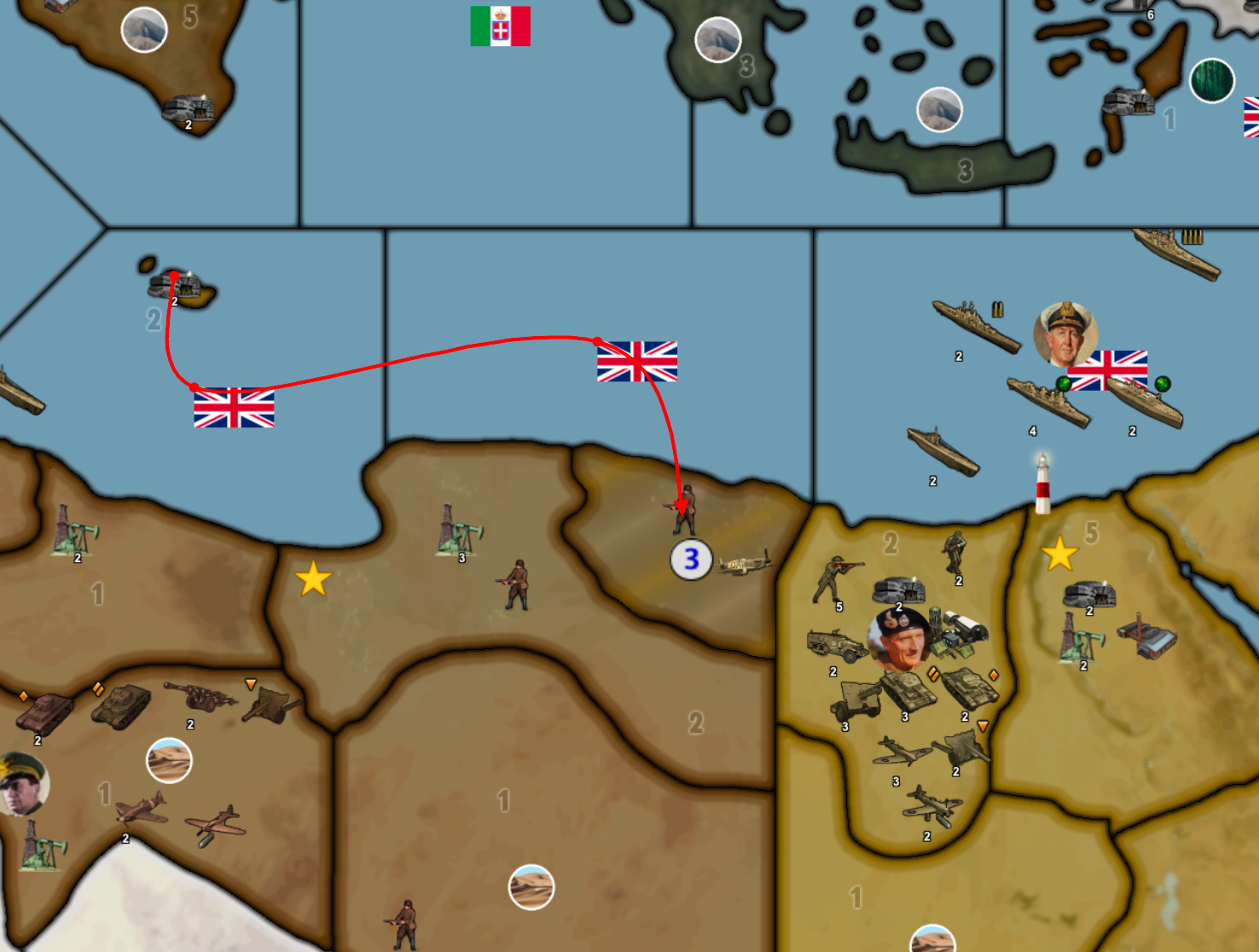
And he, reasonably, thinks to bring in the Malta-based air units to help and then to add to the defense of Alex/Cairo
So I asked him to bring up the tool tips to ensure that said fighter could help:
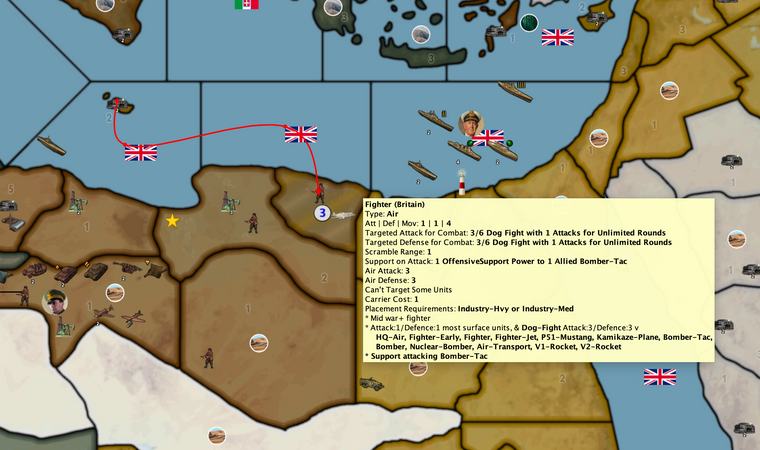
Since I DO NOT see any RED BOLD or otherwise notable tooltip restriction I assume that this Fighter COULD attack this infantry... EDIT - This was NOT using the newest game so perhaps the new game has this???
But then I recall hearing a rumor told to me by a cat that was cruising by one evening who told me about another rumor about fighters not being able to target land units or inf or something ...
Anyway please let me know if this fighter can or cannot be effective here and if not, are you doing anything in the tool tips to ensure that this knowledge is readily available ???
Cheers
-
@thedog GREAT NEWS !!!!!!!
-
@johnnycat CONTINUING ON with my young friend's indoctrination into GCD...
So we conclude that fighters cannot attack ground units (which makes no sense to me but I'm guessing you all have a reason that does make sense) he decides to use the tac bombers.
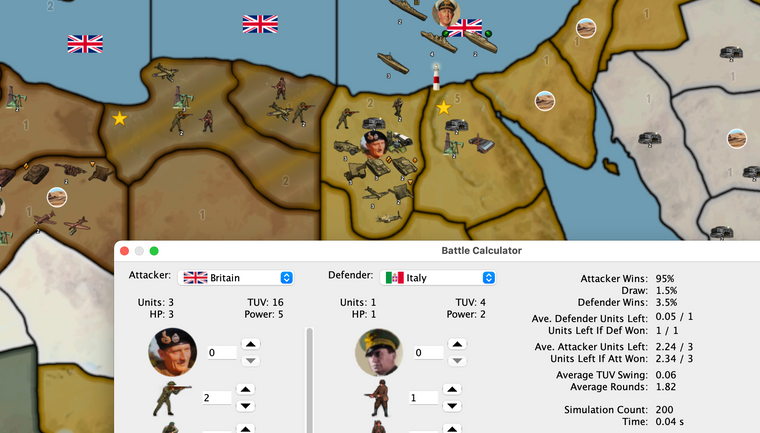
The ODDs of victory for Tobruk and the neighbor are 95%
Sounds great right?
But two seconds later the attacking force on Benghazi IS WIPED OUT
And everything in Tobruk is ALSO WIPED OUT except the attacking Tac-Bomber which limps back in total confusion and embarrassment, lol.
Does any of this make any sense ? NOTE: we ALWAYS select LOW LUCK.
Thanks
-
FAST or HARD
And I am not talking about my Girl Friend
Why when you folks post games you seem to use the AI FAST and not the AI HARD???
What is the reason for this choice?
-
@thedog Well I upgraded to v180 but despite multiple restarts I cannot seem to get any previous game saves to work nor start a new game
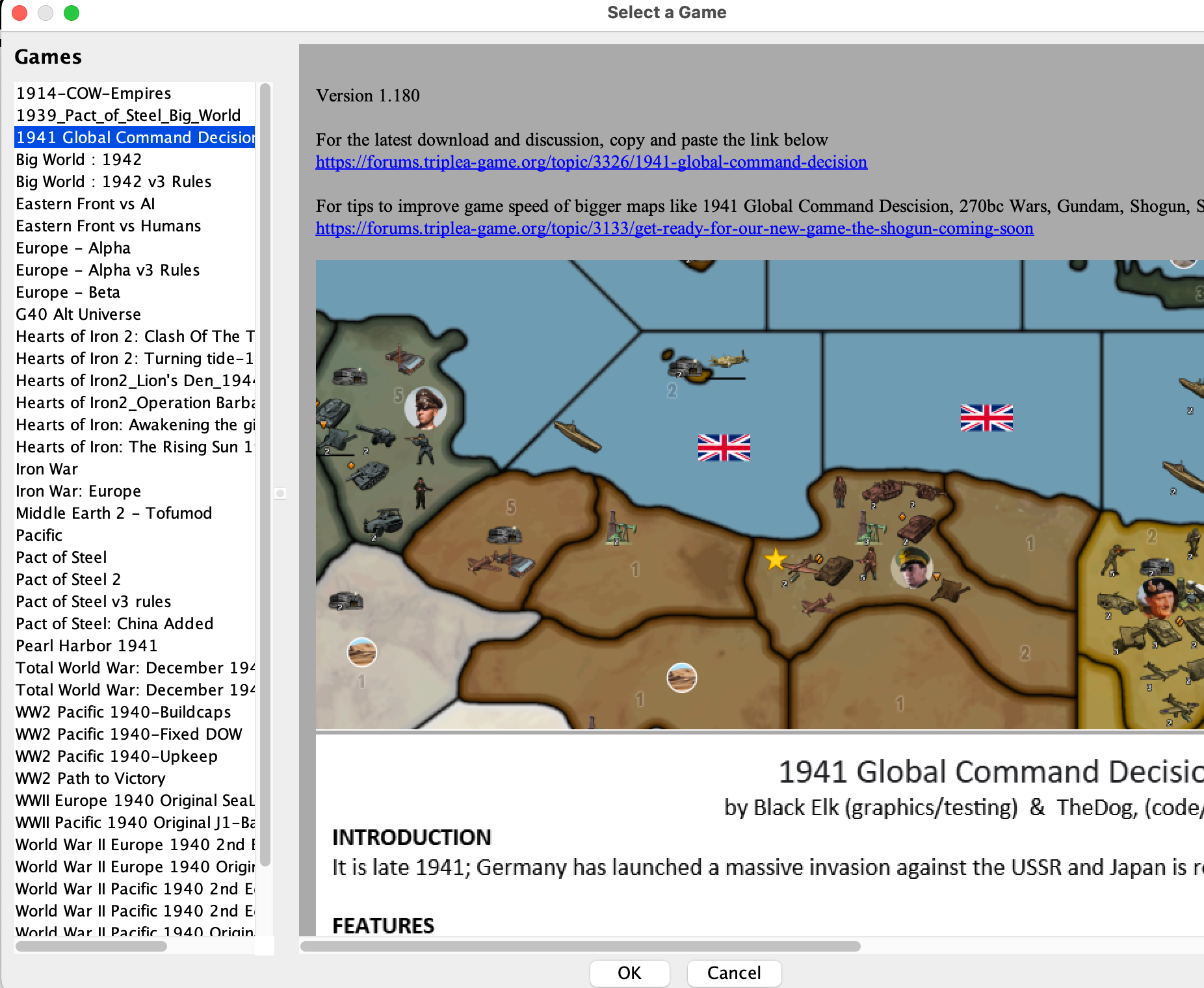
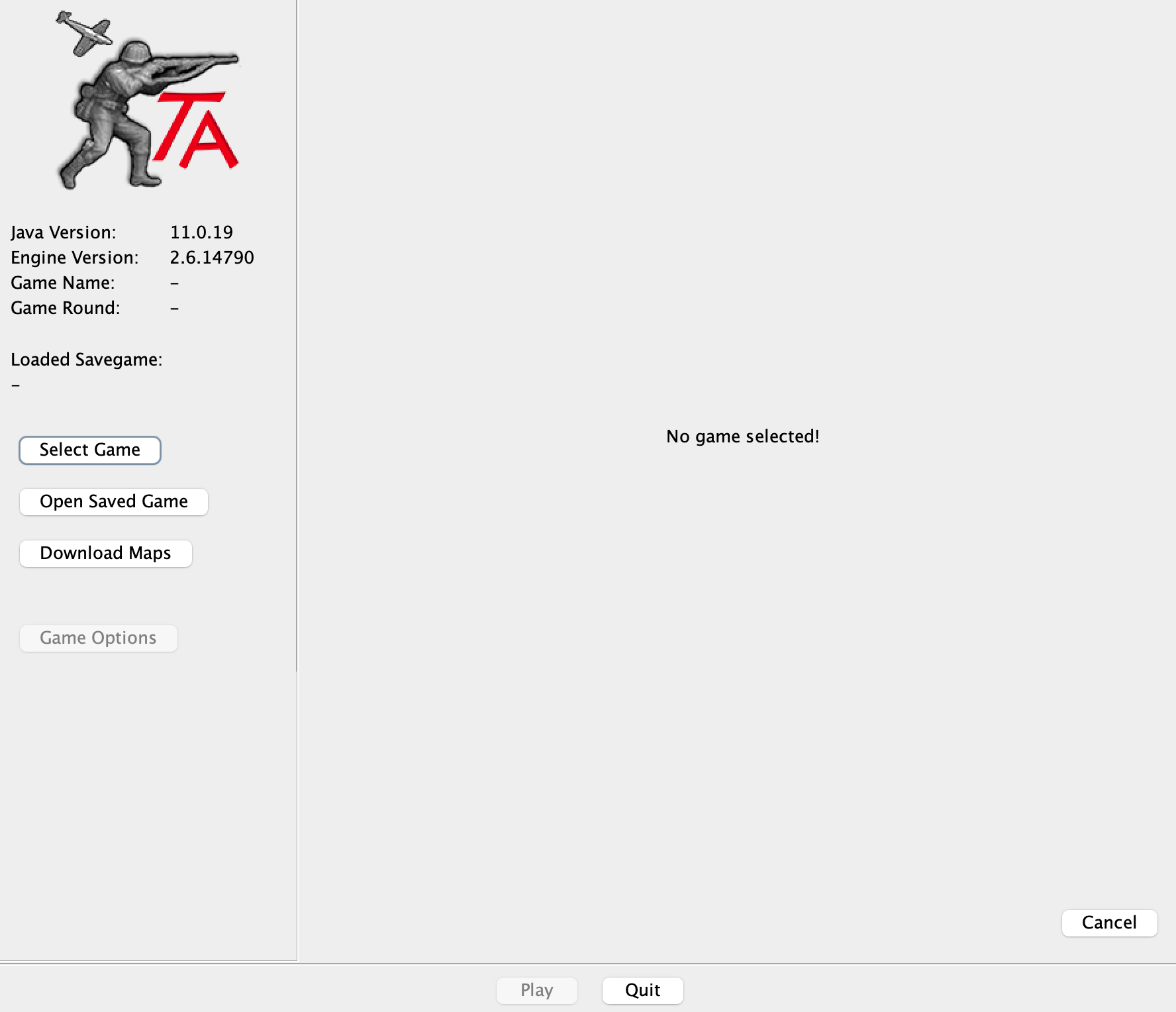
Am I doing something wrong?
-
@johnnycat
v180 does have colored Tool tips, v175 does not
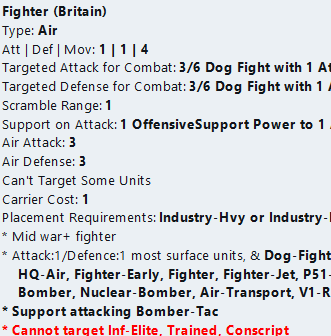
.
Fighters cannot kill Inf-Trained, etc because Fighters would look for/target high value assets and not waste their ammo on infantry that they would probably have little to no effect on. This map is trying to be a simulation of WW2.Question for you, why are using Low Luck? Try it without. I have never played with Low Luck, for me Ordinary Luck its part of the fog of war.
FastAI is faster and appears more aggressive than slower HardAI. FastAI plays more like a human would, but its your choice.
Am I doing something wrong?
No. (regarding try to load a saved game)
Regarding loading old saved games, you cannot, my bad, I will update the v180 post.
The reason is because 4 territories got renamed and they dont match your older saved games.
Either reload an old version of the map v175 or start a new game. -
@johnnycat said in
 1941 Global Command Decision - Official Thread:
1941 Global Command Decision - Official Thread:And everything in Tobruk is ALSO WIPED OUT except the attacking Tac-Bomber which limps back in total confusion and embarrassment, lol.
Bad dice. With low-luck, and you stated 1 tac survived, it would be 1 dice at 5 vs 1 dice at 2, with the following round being 1 dice at 4 with the loss of 1 infantry. If the tac is taken out during the a round of AA combat, then both attacker and defender are 1 dice at 2 until the loss of an infantry.
So, bad dice.
Cheers...
-
@thedog I APPRECIATE THIS answer very much.
you explained the fighters with logic I assumed you had - and I don’t disagree.
But because I feel most people will assume otherwise, as I did over the past year, I PLAN ON ADDING YOUR EXPLANATION to the manual !!! So thanks for spelling that out. With that explained in the manual I’ll certainly feel better about how newbies will come across such a scenario. Because THEY WILL expect those fighters to behave as in a Hollywood film lol
SIMILARLY ABOUT HARD AI vs FAST AI
Unlike what you said, and again I’ll state I don’t disagree, I feel most newbies will come to this game/(sigh, I mean “map”) with the expectations that HARD is better than FAST
And once again your explained logic is something I feel is required to be In The manual.
MOVING ON
I totally DISAGREE, however, WITH YOU about LOW LUCK. Well… maybe I do. And well maybe not.
Initially i might say something like “I’m not interested in wasting my time with any game where 2+4 sometimes equals 6 but some times equals 6 hundred and 47!!”
“No thank you” I’d go on, “I want to know that when my armored division comes upon your sword-wielding, one-eyed conscript and his three legged donkey I FREAKING WIN. “
I can’t imagine choosing the frustration that would come from playing a game with such depth and complexity as this and then introducing extreme randomness.
BUT THEN AGAIN I suspect that I know why you choose low luck and I’m starting to agree:: : You guys must be board with this game by now cause you know it so well haha
Seriously I think I understand that because now I can’t lose to the AI no matter what side I play so I too keep trying to spice it up. Only instead of adding randomness to dice rolls I prefer to make it interesting by adjusting the unit balance or introducing fantasy things like giving the Germans a nuke early or shifting the entire Italian force away from Russia or setting up an early German conquest of South America.
In any case, once again I feel we all benefit from your response so again my sincere thanks
FINALLY PLEASE REREAD WHAT I SAID
I CANNOT GET THE GAME v180 TO WORK
The territory name change makes great sense about saved games BUT as I said I cannot get a new game to work EITHER
I posted those images because that’s all I have to go on.
I’m using Macs, ofc.
Cheers
Johnny -
@wc_sumpton got it. Thx
-
@johnnycat said in
 1941 Global Command Decision - Official Thread:
1941 Global Command Decision - Official Thread:I’m using Macs, ofc.
I don't think @TheDog or myself can help, as I believe we are both using Windows.
In Windows, located in the triplea directory, within the user directory, is a text file "triplea.log", which contains error information from the engine. Maybe locating this file and posting it might help.
Cheers...
-
@wc_sumpton said in
 1941 Global Command Decision - Official Thread:
1941 Global Command Decision - Official Thread:triplea.log
Well I don't have a clue about how to install or debug software on a Mac.
And I did not find a triplea.log file.
-
@johnnycat
Then I suggest you uninstall TripleA and reinstall it. Hopefully that will fix the failure to play a new game.As wc_sumpton said I/we cannot help, we are Windows users.
-
@wc_sumpton So a closer look shows that the GCD selection IS NOT reflected in the display window.
Here is what I mean... when I select a random game(map) the title is shown in the display
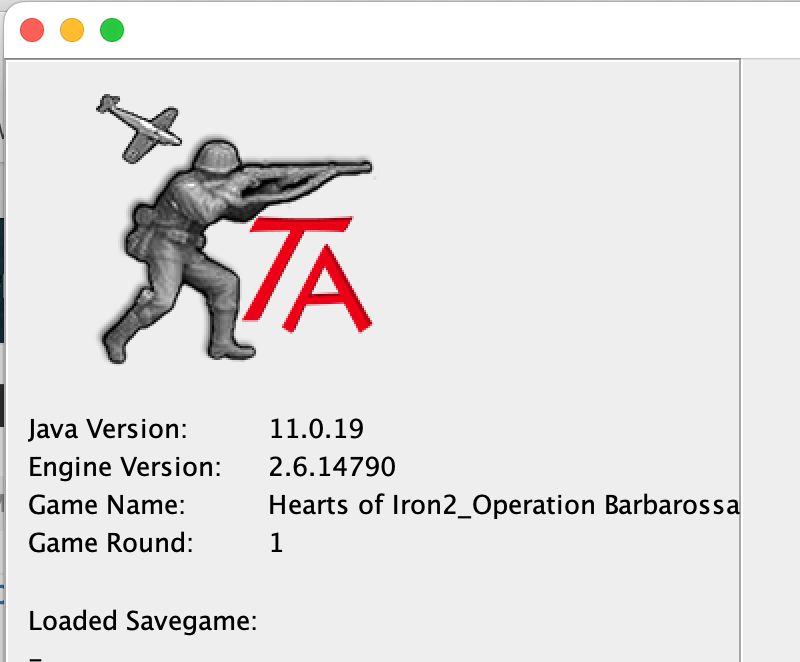
But when choosing the GCD no title is displayed.
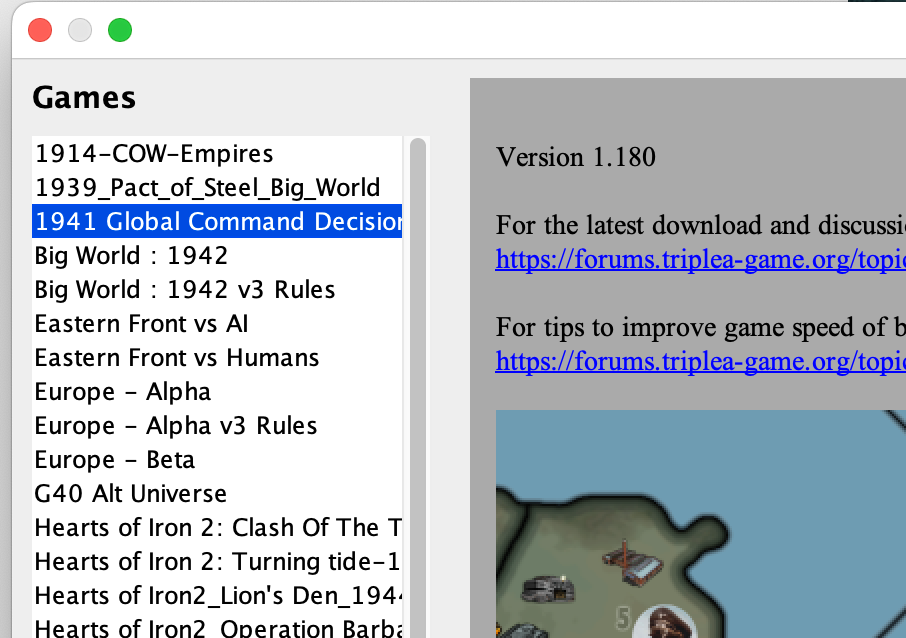
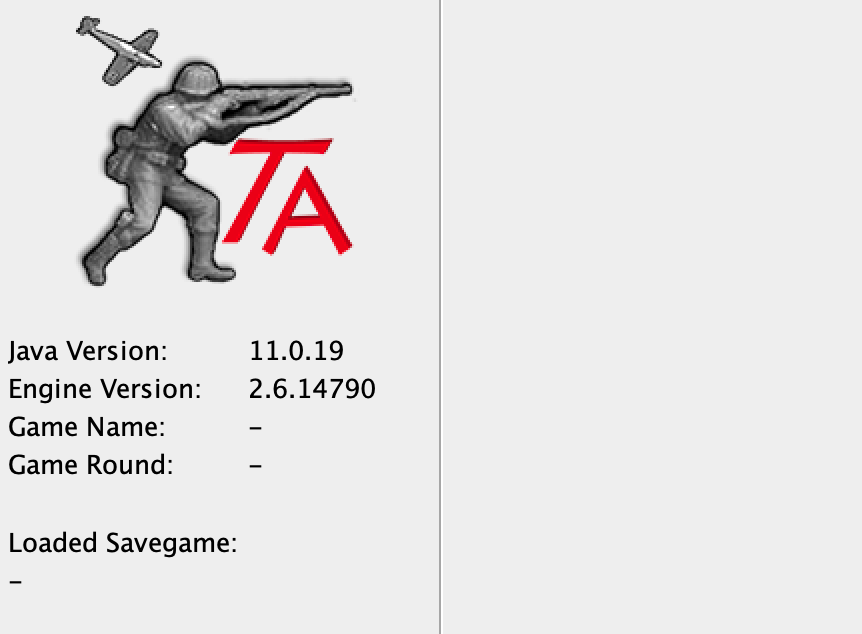
-
@johnnycat
On a mac, when try to load GCD v180 do you get a pop up that says upgrade your TripleA version to 2.7.14848+, because you should, as you are on an old version, it needs to be 2.7.14848 or higher.To upgrade your version go here
https://github.com/triplea-game/triplea/releases
and install the latest. -
@thedog WORKS PERFECTLY NOW !!!
Sorry for not even considering the version number of the TripleA engine...
At first glance I am loving the new Super Hero faces! Good job with that.
BUT I STRONGLY SUGGEST you put that little gold collar around the face circles as was discussed earlier last month. I feel very strongly that those faces just do not stand out enough and ANY sort of colored collar would go a long way at helping.
And as I recall one of you guys, maybe @beelee ??, suggested tying the color to the country. VERY GREAT IDEA THAT.
And your updated Tooltips are AWESOME Mate!!! That will help immensely !
OK. well back at the manual for me - which now is focused on concise game play examples...
Cheers
-
Sorry for not even considering the version number of the TripleA engine...
If you did not get the upgrade pop up, then you would not know you needed to upgrade.
Mac versions of TripleA can be problematic from what I have read.
